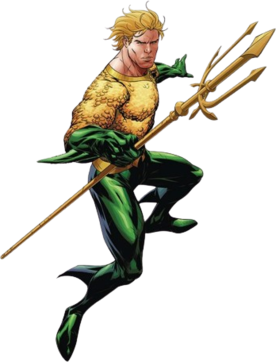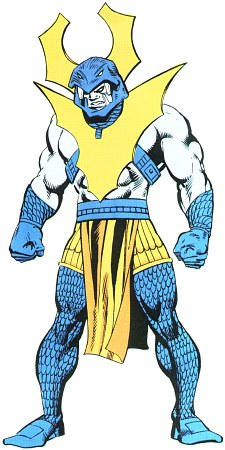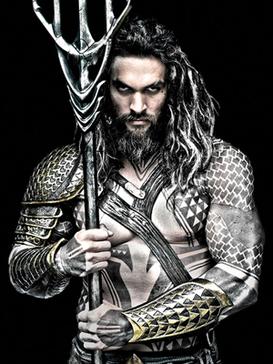
Aquaman is a superhero appearing in American comic books published by DC Comics. Created by Paul Norris and Mort Weisinger, the character debuted in More Fun Comics #73. Initially a backup feature in DC's anthology titles, Aquaman later starred in several volumes of a solo comic book series. During the late 1950s and 1960s superhero-revival period known as the Silver Age, he was a founding member of the Justice League. In the 1990s Modern Age, writers interpreted Aquaman's character more seriously, with storylines depicting the weight of his role as king of Atlantis.

The Lost World is a science fiction novel by British writer Sir Arthur Conan Doyle, published by Hodder & Stoughton in 1912, concerning an expedition to a plateau in the Amazon basin of South America where prehistoric animals still survive. It was originally published serially in the Strand Magazine and illustrated by New-Zealand-born artist Harry Rountree during the months of April–November 1912. The character of Professor Challenger was introduced in this book. The novel also describes a war between indigenous people and a vicious tribe of ape-like creatures.

The legendary island of Atlantis has often been depicted in literature, television shows, films and works of popular culture.

Ocean Master is a supervillain appearing in American comic books published by DC Comics. The character was created by Bob Haney and Nick Cardy, and debuted in Aquaman #29. The character is frequently depicted as the half-brother of Aquaman frequently plotting to usurp the throne of the fictional kingdom of Atlantis, serving as one of the heroes' most enduring and recognizable adversaries. The character has had numerous origin stories throughout his comic book history.

Attuma is a supervillain appearing in American comic books published by Marvel Comics. He is an Atlantean nomadic warlord who is usually depicted as an enemy of Namor the Sub-Mariner, and is the father of the superhero Andromeda. He believes he is the prophesied conqueror of the Atlantean Empire.

Attack from Atlantis (1953) is a science fiction novel written by Lester del Rey. The story follows the new U.S.S. Triton submarine on her maiden voyage, but trouble happens when the crew comes face to face with the inhabitants of the underwater city Atlantis.

Lagoon Boy is a fictional superhero published by DC Comics. His name and appearance are references to the title character from the classic horror feature film Creature from the Black Lagoon.

Treasures of the Deep is a video game released for the PlayStation. The player controls an underwater explorer who scours deep sea environments around the world for treasure in scuba gear and submersibles while undertaking various missions and fending off hostile pirates and sea life. It was developed by Black Ops Entertainment. The game was published in North America by Namco and by Sony Computer Entertainment in Europe, and met with strong critical approval for its compelling undersea atmosphere. The soundtrack was provided by video game composer Tommy Tallarico.

Atlantis is the fictional aquatic-based civilization appearing in American comic books published by DC Comics commonly associated with the superhero, Aquaman. Its depiction is most recognizable one within DC Comics, first appearing in Adventure Comics #260, and was created by Robert Bernstein and Ramona Fradon. Typically either a reoccurring or main setting of most Aquaman stories, the nation is characterized as being inhabited by human-like beings and creatures with biological, aquatic adaptations as well as typically following a hereditary monarchy. Atlantis is portrayed within DC Universe as being among the oldest and most powerful of civilzations on Earth due to its advanced technology and connection to the arcane forces on Earth. Beginning as a utopia, the nation would collapse to the bottom of the ocean after a cataclysmic event. Over time, the nation's history would be embordered in conflict with regards to its succession of rulers, the nation's status as a superpower, its fictional cultural heritage, and the relationship with the global world in the modern age.

The Scarlet Empire is a dystopian novel written by David MacLean Parry, a political satire first published in 1906. The book was one item in the major wave of utopian and dystopian literature that characterized the late nineteenth and early twentieth centuries.

Virgin Oceanic is an undersea leisure venture of Newport Beach, CA businessman Chris Welsh and Sir Richard Branson, part of Sir Richard Branson's Virgin Group. The brand was first reported in a 2009 Time Magazine interview. The flagship service provided by Virgin Oceanic was intended to take visitors to the deepest parts of the ocean; however, as of late 2014, the project has been put on hold until more suitable technologies are developed.
Nuidis Vulko, or simply Vulko, is a fictional character appearing in American comic books published by DC Comics. The character is a recorruing supporting character of Aquaman within the realm of Atlantis's politics. In his original portrayal, he often served under Aquaman as Atlantis's Chief Science Advisory, considered known for his loyalty, leadership and brilliant mind that enabled him to later serve as Aquaman's regent. Following the 2011 New 52 continuity reboot, Vulko is reintroduced as the chief royal advisor under Queen Atlanna. After Atlanna's supposed death, Vulko falls from grace when he claims her son, Orm Marius, is responsible. Cast out in disgrace, Vulko seeks to avenge her death by helping Arthur Curry, Atlanna's half-human elder son, gain the throne over Orm. However, Vulko's actions betray Aquaman's trust, making him a criminal and a reluctant ally for a period of time.

Arthur Conan Doyle KStJ, DL (1859–1930) was a Scottish writer and physician. In addition to the series of stories chronicling the activities of Sherlock Holmes and his friend Dr John Watson for which he is well known, Doyle wrote on a wide range of topics, both fictional and non-fictional. In 1876 Doyle entered the University of Edinburgh Medical School, where he became a pupil of Joseph Bell, whose deductive processes impressed his pupil so much that the teacher became the chief model for Holmes. Doyle began writing while still a student, and in October 1879 he had his first work—"The Mystery of the Sasassa Valley"—published in Chambers's Journal. He continued writing short works—both fictional and non-fictional—throughout his career, and had over 200 stories and articles published.
The Trench is the name applied to both a fictional kingdom, and its inhabitants as a group, that escaped the destruction of Atlantis in DC comics.

Justice League: Throne of Atlantis is a 2015 direct-to-video animated superhero film featuring the DC Comics superhero team the Justice League, which is the 22nd film of the DC Universe Animated Original Movies and the fourth film in the DC Animated Movie Universe. The film is loosely based on the "Throne of Atlantis" story arc from The New 52 written by Geoff Johns and serves as a standalone sequel to 2014's Justice League: War. In the film, Arthur Curry, a half-Atlantean prince, discovers his heritage and aids the Justice League in preventing a war between the surface dwellers and the Atlanteans orchestrated by his half-brother Ocean Master. The film was released for download on January 13, 2015 and was released on Blu-ray and DVD formats on January 27.
Diving support equipment is the equipment used to facilitate a diving operation. It is either not taken into the water during the dive, such as the gas panel and compressor, or is not integral to the actual diving, being there to make the dive easier or safer, such as a surface decompression chamber. Some equipment, like a diving stage, is not easily categorised as diving or support equipment, and may be considered as either.
The fictional island of Atlantis frequently appears in popular culture, especially in comic books. The most notable examples are commonly related to Namor of Marvel Comics and a particular version of Aquaman in DC Comics.

Arthur Curry, also known by his superhero moniker Aquaman, is a fictional character in the DC Extended Universe based on the DC Comics superhero of the same name. He is portrayed by American actor Jason Momoa. Originally appearing as a cameo in Batman v Superman: Dawn of Justice, Curry had a prominent role in the film Justice League and its director's cut, and is later the subject of his own film Aquaman. Momoa also cameoed in the first season finale of the HBO Max series Peacemaker and the film The Flash. The DCEU marks Aquaman's first portrayal in cinema, with his character having been re-imagined as compared to his comics counterpart.














